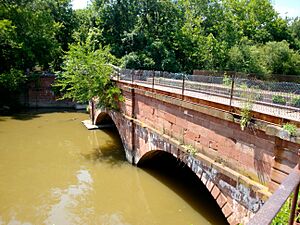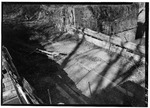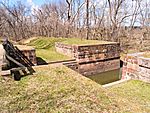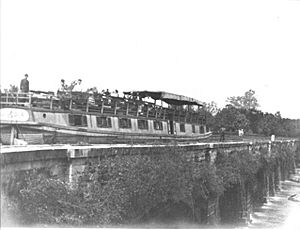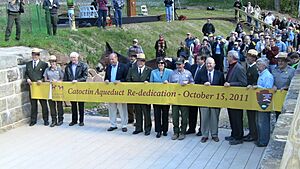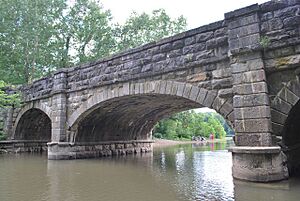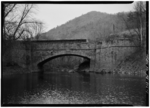- This page was last modified on 17 October 2025, at 10:18. Suggest an edit.
Aqueducts on the C&O Canal facts for kids
The Chesapeake and Ohio Canal (C&O) needed special bridges called aqueducts. These aqueducts carried the canal's water over wide rivers and streams. Imagine a water bridge! The C&O Canal used 11 of these amazing structures. The people who built the canal called them "works of art."
Besides these 11, there was also the Alexandria Aqueduct. It connected the C&O Canal to Alexandria, Virginia. Another one was the Broad Run Trunk Aqueduct. It was made of wood and was not officially called an aqueduct by the canal company.
Unlike the very old Roman aqueducts, the C&O aqueducts were not built to last forever. They often got damaged by floods. Trash carried by floodwaters caused a lot of harm.
Contents
- Seneca Aqueduct: The Watermelon Crash Site
- Broad Run Trunk: The Unofficial Aqueduct
- Monocacy Aqueduct: The Longest Water Bridge
- Catoctin Aqueduct: The "Crooked" One
- Antietam Creek Aqueduct
- Conococheague Creek Aqueduct: A Dramatic Collapse
- Licking Creek Aqueduct: The Shortest One
- Tonoloway Creek Aqueduct: Built into a Cliff
- Sideling Hill Creek Aqueduct
- Fifteen Mile Creek Aqueduct
- Town Creek Aqueduct
- Evitts Creek Aqueduct
- Images for kids
Seneca Aqueduct: The Watermelon Crash Site
The Seneca Aqueduct was the first aqueduct on the canal. It was built in Montgomery County, Maryland. This aqueduct also had a lock nearby, called Riley's Lock. It crossed over Seneca Creek. Workers built it between 1829 and 1832. Sadly, it fell apart in 1971 because of a big flood.
Right next to the aqueduct, there was a stone cutting mill. This mill used water from the canal to power its machines. It cut stone from nearby quarries.
Something exciting happened here in 1897! A passenger boat was leaving the aqueduct. It crashed into a freight boat full of watermelons. Luckily, no one was hurt when the passenger boat sank. But the best part? Local people got to collect free watermelons floating in the water!
Broad Run Trunk: The Unofficial Aqueduct
This aqueduct was "unofficial" because the company still called it a culvert. It crosses Broad Run in Montgomery County. It started as two stone tunnels in 1829. It was finished in 1833.
But it washed out in a flood in 1846. So, a wooden structure was put in its place to keep the canal open. This wooden part wore out and was rebuilt in 1856. During the American Civil War, soldiers burned it down. It had to be replaced again! The wood kept rotting, so it needed constant repairs.
Monocacy Aqueduct: The Longest Water Bridge
The Monocacy Aqueduct is the longest aqueduct on the C&O Canal. It is in Frederick County, Maryland. This huge structure crosses the Monocacy River. It was completed in May 1833.
It is 516 feet (about 157 meters) long. It has seven large arches, each 54 feet (about 16 meters) wide. Building started in March 1829. The stone for it came from nearby Sugar Loaf Mountain. Some stone was floated down the river. Other stone was moved by a special wagon track with iron-covered oak rails.
Catoctin Aqueduct: The "Crooked" One
The Catoctin Aqueduct crosses Catoctin Creek in Frederick County. It was finished in 1834. People called it the "Crooked Aqueduct." This was because the canal made sharp turns just before and after it.
Sometimes, boat captains went too fast. This caused accidents and damaged the aqueduct's sides. In 1870, the canal company ordered all boats to slow down. They even hired a watchman to make sure everyone followed the rules! Boatmen also called this creek "Jug Creek."
This aqueduct was made from granite. It used two different types of arches, which caused problems. It was known as the worst-built structure on the canal. It leaked a lot starting in 1859. It finally collapsed on October 31, 1973.
But there's a happy ending! Between 2007 and 2010, money was raised to fix it. In 2010, the National Park Service started the restoration work. They found 459 original stones and used them to rebuild it. The aqueduct reopened on October 15, 2011.
Antietam Creek Aqueduct
The Antietam Creek Aqueduct was started in 1832. It was finished in April 1835.
Conococheague Creek Aqueduct: A Dramatic Collapse
The Conococheague Creek Aqueduct was built by Michael Byrne. Work began in 1833 and finished in November 1835. It is located at the 99.80-mile mark of the canal.
This aqueduct was made of local limestone. It was damaged during the Civil War by a group called Mosby's Raiders. The stone wall of the aqueduct broke three times: in 1865, 1887, and finally in 1920.
On April 20, 1920, the wall broke again. Boat #73 was returning to Cumberland. The boat hit the wall, and Captain Myers saw it shake. He quickly told his stepson to let go of the mules that pulled the boat. The wall collapsed, and the boat fell into the creek. Captain Myers jumped to safety. Everyone survived the accident!
The National Park Service started a project in 2017 to fix this aqueduct. They want to make it look like it did in the 1920s. They also plan to put water back into this part of the canal.
Licking Creek Aqueduct: The Shortest One
The Licking Creek Aqueduct was started in 1835. It was finished in May 1838. This is the shortest aqueduct on the canal, only 50 feet (about 15 meters) long.
Tonoloway Creek Aqueduct: Built into a Cliff
Building the Tonoloway Creek Aqueduct began in 1835. It was completed in April 1839. This aqueduct has an interesting design. One end was built right into a limestone cliff! Like many other aqueducts, it also has a waste weir. A waste weir is a special opening that lets out extra water from the canal.
Sideling Hill Creek Aqueduct
The Sideling Hill Creek Aqueduct was started in 1837. It was finished in the spring of 1850.
Fifteen Mile Creek Aqueduct
The Fifteen Mile Creek Aqueduct was started in 1838. Work stopped and started again. It was finally finished in the summer of 1850. This aqueduct is located just upstream from Little Orleans, Maryland.
Town Creek Aqueduct
The Town Creek Aqueduct was also started in 1838. Like some others, its construction was paused. Another builder took over in 1847. It was completed in the summer of 1850. The Western Maryland Railway built a bridge right next to this aqueduct.
Evitts Creek Aqueduct
The Evitts Creek Aqueduct was started in 1838. It was the last of the 11 aqueducts to be finished. It was finally completed in the spring of 1850.

